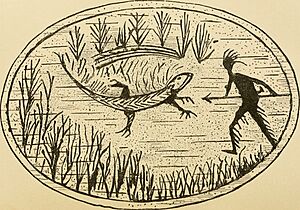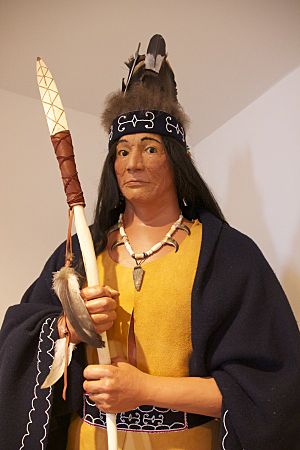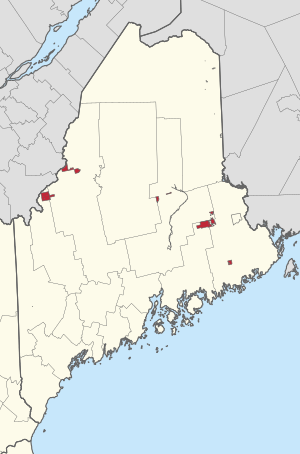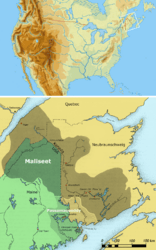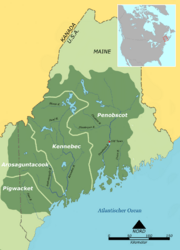Passamaquoddy facts for kids
| Peskotomuhkati | |
|---|---|

Passamaquoddy men in a canoe (2016)
|
|
| Total population | |
3,575 enrolled tribal members
|
|
| Regions with significant populations | |
| United States (Maine) | 3,369 (0.3%) |
| Canada (New Brunswick) | 206 (0.03%) |
| Languages | |
| Maliseet-Passamaquoddy, English | |
| Religion | |
| Wabanaki mythology, Christianity | |
| Related ethnic groups | |
| Abenaki, Maliseet, Mi'kmaq, Penobscot | |
The Passamaquoddy (in their own language: Peskotomuhkati) are a Native American and First Nations people. They live in the northeastern part of North America. Their traditional home, called Peskotomuhkatik, is in both the Canadian province of New Brunswick and the U.S. state of Maine. This area is also known as Dawnland. The Passamaquoddy are one of the groups that make up the Wabanaki Confederacy.
In Maine, the Passamaquoddy Tribe is officially recognized by the government. This means they have a special relationship with the U.S. government. Passamaquoddy people in Canada have their own organized government. However, they do not yet have official First Nations status from the Canadian government.
Contents
What Does the Name Passamaquoddy Mean?
The name "Passamaquoddy" comes from the Passamaquoddy word peskotomuhkati. This word describes "those of the place where pollock are plentiful." It also means "pollock-spearer." This shows how important the pollock fish was to their culture. They used spears to catch fish, not nets or fishing rods. Passamaquoddy Bay, which is between New Brunswick and Maine, was named after the Passamaquoddy people by early English settlers.
A Look at Passamaquoddy History
Before Europeans arrived, the Passamaquoddy shared their history through spoken stories. They also used pictures etched into birch bark and carved into rocks. They lived along the coasts of the Bay of Fundy, Passamaquoddy Bay, and the Gulf of Maine. They also lived along the St. Croix River and its smaller streams.
Life Before European Contact
The Passamaquoddy had a seasonal way of life. In winter, they spread out and hunted inland. In summer, they gathered closer together on the coast and islands. During summer, they mainly harvested seafood. This included sea mammals, shellfish, crabs, and fish.
Changes to Passamaquoddy Lands
Starting in the 1800s, European settlers often forced the Passamaquoddy off their traditional lands. After the United States became independent, the tribe was given specific areas. These areas are the current Passamaquoddy Indian Township Reservation and the Passamaquoddy Pleasant Point Reservation. Both are in eastern Washington County, Maine.
The Passamaquoddy also live on trust lands that are not part of the reservations. These lands are in five different counties in Maine. They are much larger than the reservations themselves.
Some Passamaquoddy also live in Charlotte County, New Brunswick, Canada. They have their own chief and government there. They are working to get back land in Canada. They claim that present-day St. Andrews, New Brunswick was once their important ancestral capital and burial ground, called Qonasqamkuk.
Passamaquoddy People and Their Languages
There are about 3,576 Passamaquoddy people in total. Around 500 of them, mostly over 50 years old, speak the Maliseet-Passamaquoddy language. This language is also spoken by the nearby Maliseet people, with only small differences. It is part of the Algonquian language family.
The University of Maine published a full Passamaquoddy Dictionary in 2008. There is also an online Passamaquoddy-Maliseet Language Portal. It has many videos of native speakers talking in their language, with subtitles in English and Passamaquoddy. Most Passamaquoddy people today speak English as their main language.
The Passamaquoddy population in Canada is smaller than in Maine. However, they have a formal structure and a chief, Hugh Akagi. Most of them speak French and English. The Canadian government does not officially recognize them as a First Nation yet. In 2004, Chief Akagi was allowed to represent the Passamaquoddy at an event. This event marked 400 years since the French first tried to settle at Saint Croix Island, Maine. This shows that the government is starting to acknowledge the tribe.
Special Status in Maine's Government

The Passamaquoddy, along with the nearby Penobscot people, have a special political status in Maine. Both groups can send a representative to the Maine House of Representatives. This representative cannot vote on laws. However, they can suggest any laws about American Indian affairs. They can also help suggest any other laws.
Famous Passamaquoddy Individuals
- David Moses Bridges (1962–2017), a birchbark artist and canoe maker.
- Simon Dumont, a freestyle skier.
- Tomah Joseph (1837–1914), a governor, guide, and artist.
- Francis Joseph Neptune, a former leader (Sakom).
- Molly Neptune Parker, a master basketmaker.
- Geo Soctomah Neptune, a master basketmaker.
- Rena Newell, a tribal member in the Maine House of Representatives.
- Wayne Newell, an educator, singer, and language preservationist. He was also a former tribal state representative and tribal council member.
- Donald Soctomah, a former tribal state representative and tribal historic preservation officer.
- Madonna Soctomah, a tribal council member and former state representative.
Maps of Wabanaki Lands
These maps show where the different groups of the Wabanaki Confederacy lived (from north to south):
-
Maliseet, Passamaquoddy
-
Eastern Abenaki (Penobscot, Kennebec, Arosaguntacook, Pigwacket/Pequawket)
-
Western Abenaki (Arsigantegok, Missisquoi, Cowasuck, Sokoki, Pennacook)
See also
 In Spanish: Passamaquoddy para niños
In Spanish: Passamaquoddy para niños


